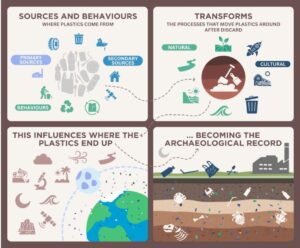
It is often perceived as the scourge of modern society, yet a new study suggests that modern plastics serve as a valuable archive, documenting human activities and behaviors at a pivotal moment in history. This dual perspective emerges as the United Nations estimates that 400 million tonnes of plastic are produced annually, presenting one of the most significant threats to the environment.
Beyond the environmental impact, microplastic particles infiltrate water, soil, and air, interacting with humans, animals, and plants. However, lead author Professor John Schofield from the University of York in England argues that plastics also narrate the story of the modern era. “It is easy to view plastics as a toxic legacy and the cause of environmental harm, which of course they are. But as archaeologists, we can also view them from another angle entirely – as a valuable archive that documents human impacts on planetary health,” he states.
Plastics: A Global Phenomenon and Archive
Plastics are omnipresent, from the depths of the ocean to the heights of mountains. They are resilient and toxic, breaking down continually to nanoscale. The study, involving experts from Flinders University, including archaeologist Associate Professor Alice Gorman, questions how society should perceive an archaeological record that is both a valuable archive and a dangerous contaminant threatening planetary health.
Professor Schofield, who also collaborates with Flinders University, worked alongside a cross-disciplinary team of researchers from archaeology, history, chemistry, and earth sciences to conduct the study. With contributions from UK academic Dr. Fay Couceiro and Dr. Alessandro Antonello from the University of Tasmania, the paper explores the potential of the planet’s Plastic Age to study human relationships with the world, akin to how archaeologists examine stone tools, metal, and ceramics from the past.
The Plastic Age: A New Archaeological Era
The Plastic Age, unlike previous periods, began simultaneously worldwide in the 1950s, making it a global phenomenon intertwined with contemporary issues such as consumerism, habitat destruction, and fossil fuel combustion. Published in the journal Cambridge Prisms: Plastics, the study argues that archaeology is uniquely positioned to illuminate the processes of plastic pollution and document contemporary events and human behaviors, creating an ‘archaeology of us.’
In recent years, archaeology has broadened to encompass not only the study of the deeper past but also how people in modern societies interact with their environment through the material culture they leave behind. The study’s authors propose viewing the environment as an archaeological archive, which can be studied to understand and mitigate plastic pollution. They suggest focusing interventions at the point when plastics transition from everyday use to discarded contexts.
Implications and Future Directions
Professor Schofield emphasizes the importance of archaeologists’ interest in plastics, stating, “Only recently have archaeologists started taking an interest in plastics, and it is vital that they do. We need this archive, both to help us understand and try to reduce our impacts now but also to ensure people can understand these impacts in the future.”
Flinders University Professor of Archaeology Alice Gorman adds, “Our aim is to show how plastics are more than just pollution – they’re a record of human behavior in the contemporary world that extends from the deepest oceans to the furthest reaches of the solar system, everywhere that spacecraft have traveled. There are even plastics on the Moon. Archaeology ties all these environments together because it looks at how human materials decay in different conditions.”
This study represents a shift in perspective, encouraging a view of plastics not merely as pollutants but as historical records. As society grapples with the environmental challenges posed by plastics, this research underscores the importance of understanding our material legacy to inform future actions and policies.







